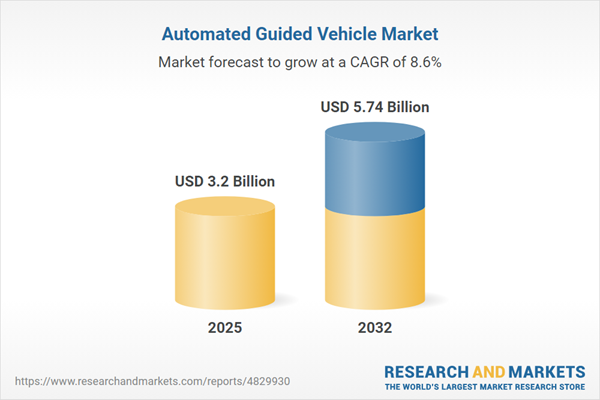Speak directly to the analyst to clarify any post sales queries you may have.
The Automated Guided Vehicle (AGV) market is experiencing rapid transformation as advanced technologies reshape how global industries manage material flow, respond to labor shortages, and pursue strategic automation goals. AGVs now play a central role in optimizing internal logistics across manufacturing, warehousing, and distribution environments, offering decision-makers new opportunities for operational efficiency and adaptability.
Market Snapshot: Automated Guided Vehicle Market Growth and Outlook
The Automated Guided Vehicle market grew from USD 2.96 billion in 2024 to USD 3.20 billion in 2025. It is projected to expand at a CAGR of 8.62%, reaching USD 5.74 billion by 2032. Industry momentum is driven by demand for warehouse automation, integrated intralogistics, and the ability to respond to dynamic manufacturing needs with flexible automated solutions. This growth reflects the increasing adoption of AGVs across diverse sectors, as organizations aim to enhance throughput, precision, and supply chain responsiveness.
Scope & Segmentation of the Automated Guided Vehicle Market
- Component: Hardware (Actuators, Controllers, Sensors), Software (Fleet Management, Navigation), Services (Deployment & Integration, Maintenance & Support)
- Vehicle Type: Cart AGV, Forklift AGV, Hybrid AGVs, Towing AGV, Unit Load Carriers
- Navigation Technology: Laser Guidance, Magnetic Tape or Spot Navigation, Wired Navigation
- Payload Capacity: Less than 100 kg, 100–500 kg, More than 500 kg
- End-User: Food & Beverage, Healthcare, Logistics & Warehousing, Manufacturing, Retail
- Distribution Channel: Offline, Online
- Geographical Coverage: Americas (United States, Canada, Mexico, Brazil, Argentina, Chile, Colombia, Peru), Europe/Middle East/Africa (including UK, Germany, France, Russia, Italy, Spain, Netherlands, Sweden, Poland, Switzerland, UAE, Saudi Arabia, Qatar, Turkey, Israel, South Africa, Nigeria, Egypt, Kenya), Asia-Pacific (China, India, Japan, Australia, South Korea, Indonesia, Thailand, Malaysia, Singapore, Taiwan)
- Companies Analyzed: ABB Ltd., Aethon Inc., Alstef Group SAS, Clearpath Robotics by Rockwell Automation, Daifuku Co Ltd., Dematic Corp., Geekplus Technology Co. Ltd., Hitachi Ltd., Hyster-Yale Inc., inVia Robotics Inc., Kion Group, KUKA AG, Linde Material Handling GmbH, Mitsubishi Heavy Industries Ltd., Murata Manufacturing Co. Ltd., Omron Corporation, Robotic Automation P/L, Seegrid Corporation, SIASUN Robot & Automation CO Ltd, Siemens AG, Strothmann Machines & Handling GmbH, Teradyne Inc, TOSHIBA CORPORATION, Toyota Material Handling Inc, Vecna Robotics Inc., Yaskawa Electric Corporation
Key Takeaways for Senior Decision-Makers
- AGVs deliver measurable efficiency by automating material movement, minimizing errors, and supporting continuous operations without the constraints of manual labor.
- Integration of AI, robotics, and advanced sensor technologies enables real-time analytics, predictive maintenance, and agile response to shifting operational demands.
- Modular, interoperable AGV platforms facilitate seamless upgrades and third-party integration, reducing long-term system obsolescence and supporting scalable automation strategies.
- Simulation tools like digital twins accelerate deployment by revealing configuration issues before live implementation, lowering project risk and reducing downtime.
- Cloud-based fleet management democratizes data-driven optimization, empowering organizations of all sizes to monitor, configure, and improve system performance remotely.
- Cross-industry adoption, from food and beverage to healthcare and ecommerce, demonstrates the adaptability of AGVs to diverse process, compliance, and throughput needs.
Tariff Impact on Supply Chains and Vendor Strategies
New United States tariff measures in 2025 are compelling AGV stakeholders to review sourcing, supplier contracts, and component procurement strategies. The inclusion of duties on core AGV hardware—from actuators and controllers to precision sensors—has led companies to evaluate domestic assembly, diversify supplier networks, and adopt hybrid sourcing models. Service providers and end users are revising agreements and implementing flexible pricing to address fluctuating costs, underlining the importance of proactive risk management and agile partnership models.
Methodology & Data Sources
This report is based on a mixed methods approach combining expert interviews, quantitative analysis of transactional data, and validation by independent subject matter experts. Interviews with executives, managers, and technical architects ensure relevance to real-world deployment, while data triangulation protocols reinforce accuracy and credibility throughout the research process.
Why This Report Matters for Senior Leaders
This research gives decision-makers clear visibility into AGV market trends and actionable insights for competitive positioning. Key benefits include:
- Guidance on optimizing AGV investments with modular, upgrade-ready solutions to safeguard ROI and flexibility.
- Strategies for navigating regulatory and supply chain complexities to sustain operational resilience.
- Benchmarking best practices across leading industries and regions to inform strategic roadmaps and risk mitigation.
Conclusion
The Automated Guided Vehicle market continues to evolve through a synthesis of technological advancement, strategic supply chain adjustments, and regionally tailored adoption. Decision-makers can leverage these insights to accelerate automation initiatives, manage risk, and strengthen operational agility for long-term competitiveness.
Additional Product Information:
- Purchase of this report includes 1 year online access with quarterly updates.
- This report can be updated on request. Please contact our Customer Experience team using the Ask a Question widget on our website.
Table of Contents
3. Executive Summary
4. Market Overview
7. Cumulative Impact of Artificial Intelligence 2025
Companies Mentioned
The companies profiled in this Automated Guided Vehicle market report include:- ABB Ltd.
- Aethon, Inc.
- Alstef Group SAS
- Clearpath Robotics by Rockwell Automation
- Daifuku Co., Ltd.
- Dematic Corp.
- Geekplus Technology Co., Ltd.
- Hitachi, Ltd.
- Hyster-Yale, Inc.
- inVia Robotics, Inc.
- Kion Group
- KUKA AG
- Linde Material Handling GmbH
- Mitsubishi Heavy Industries, Ltd.
- Murata Manufacturing Co., Ltd.
- Omron Corporation
- Robotic Automation P/L
- Seegrid Corporation
- SIASUN Robot & Automation CO.,Ltd
- Siemens AG
- Strothmann Machines & Handling GmbH
- Teradyne Inc
- TOSHIBA CORPORATION,
- Toyota Material Handling, Inc
- Vecna Robotics Inc.
- Yaskawa Electric Corporation
Table Information
| Report Attribute | Details |
|---|---|
| No. of Pages | 197 |
| Published | November 2025 |
| Forecast Period | 2025 - 2032 |
| Estimated Market Value ( USD | $ 3.2 Billion |
| Forecasted Market Value ( USD | $ 5.74 Billion |
| Compound Annual Growth Rate | 8.6% |
| Regions Covered | Global |
| No. of Companies Mentioned | 27 |









